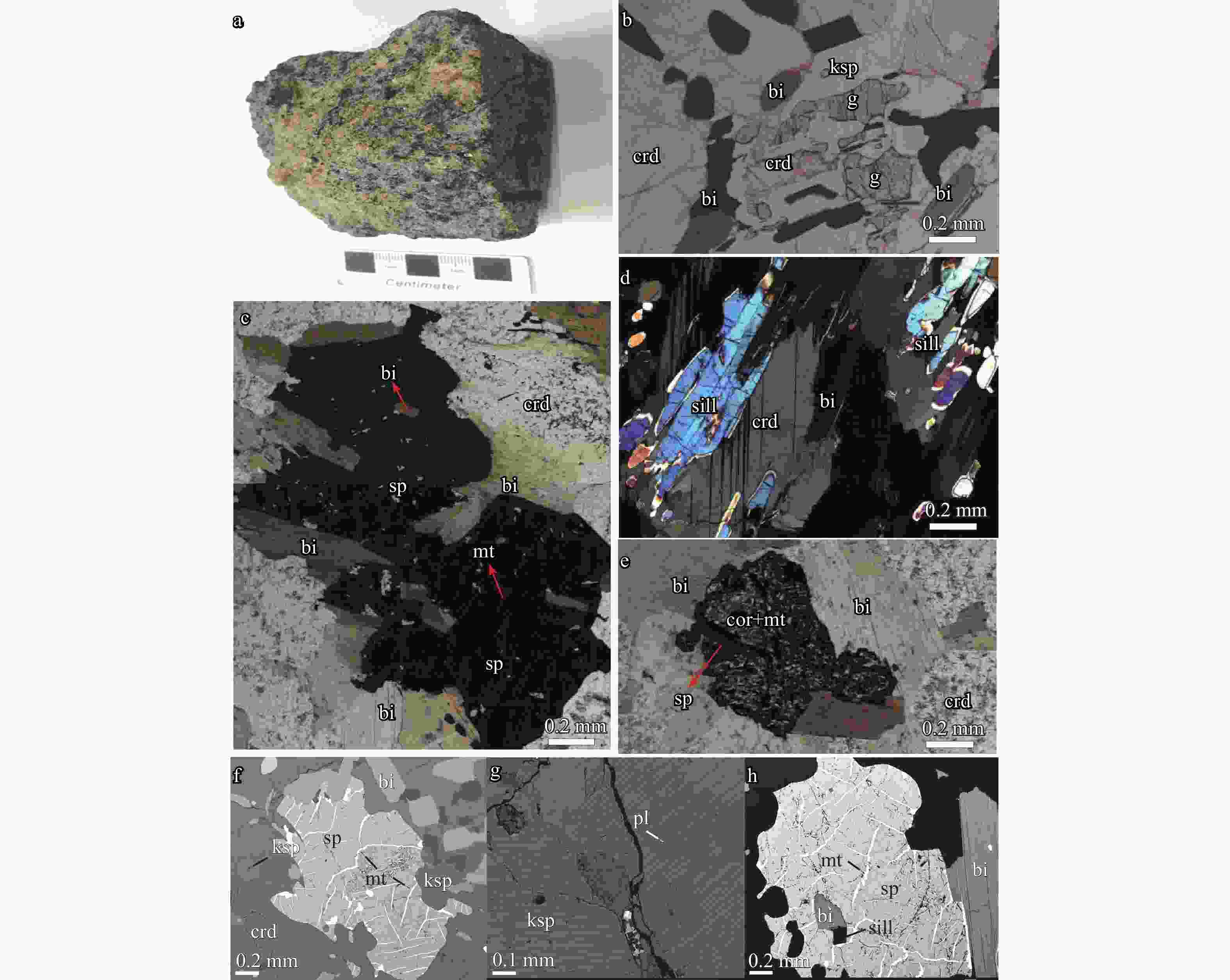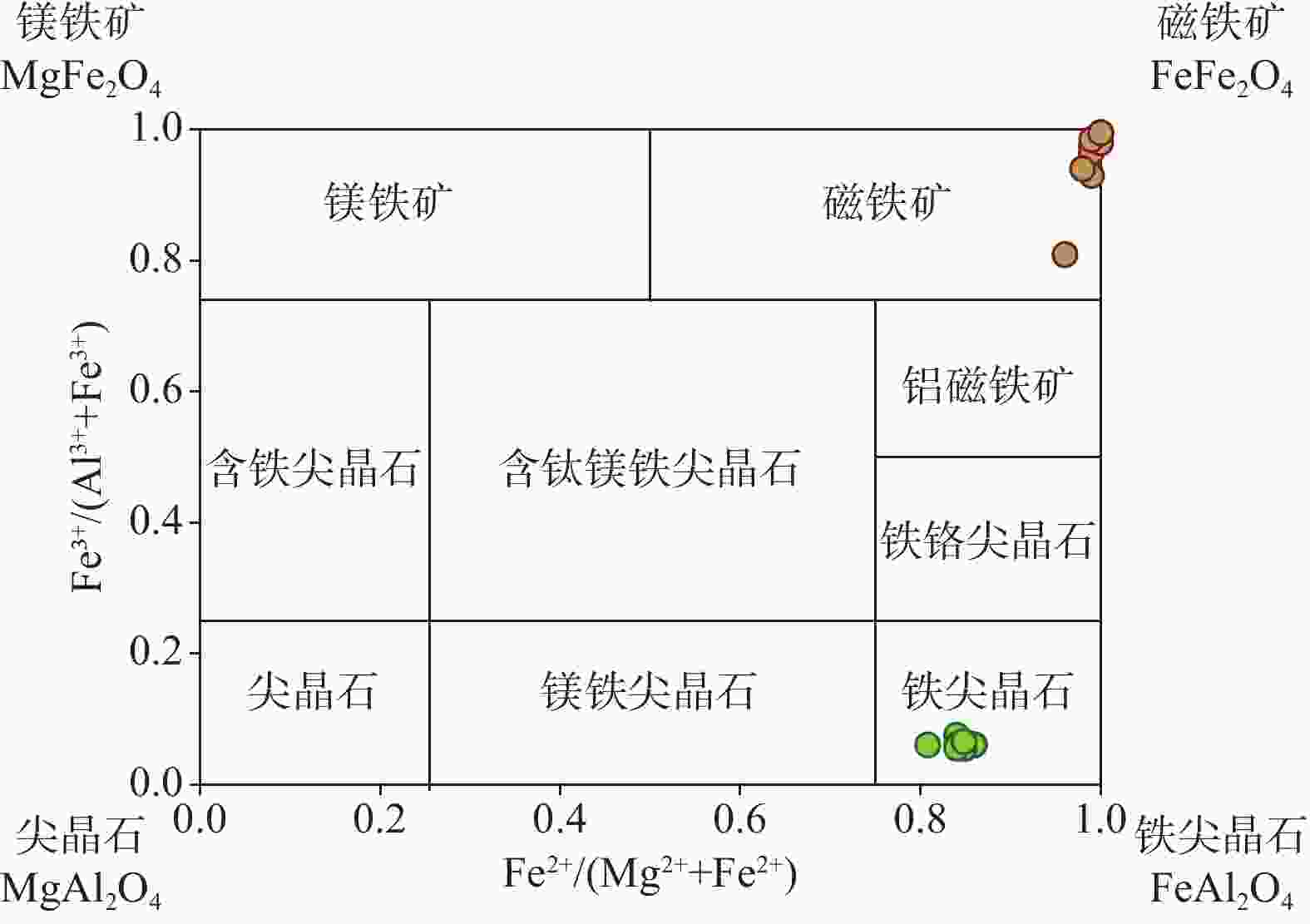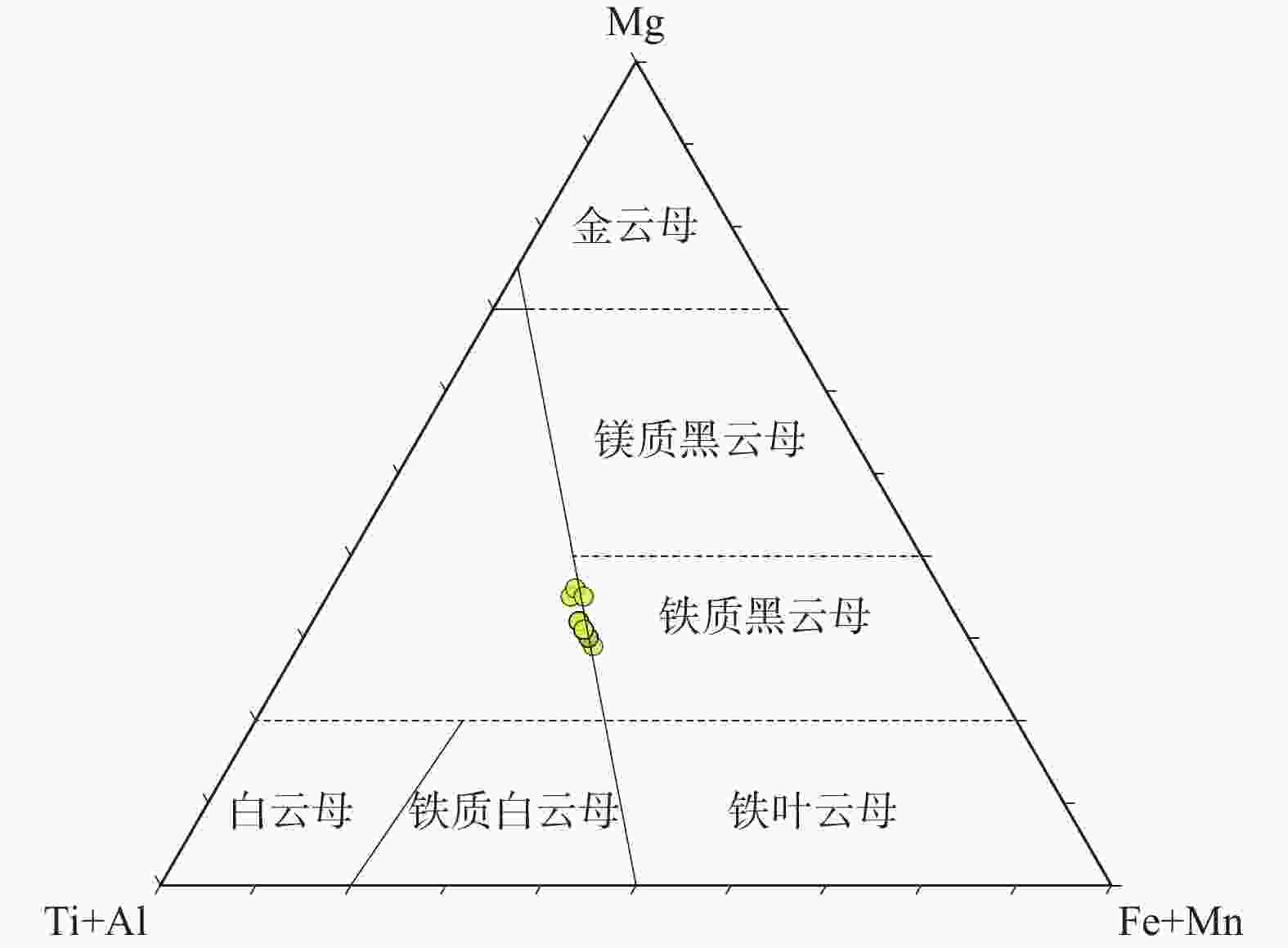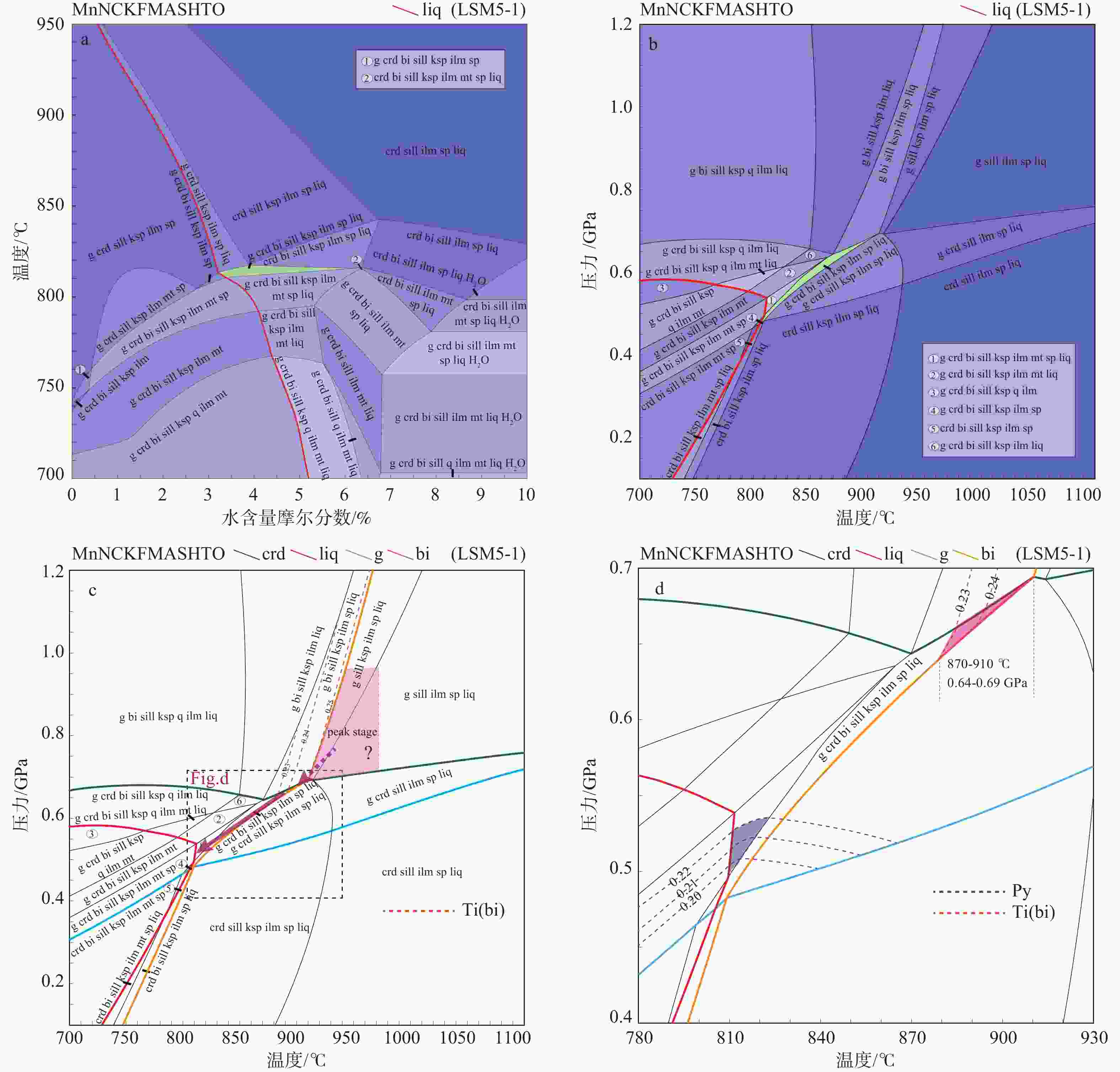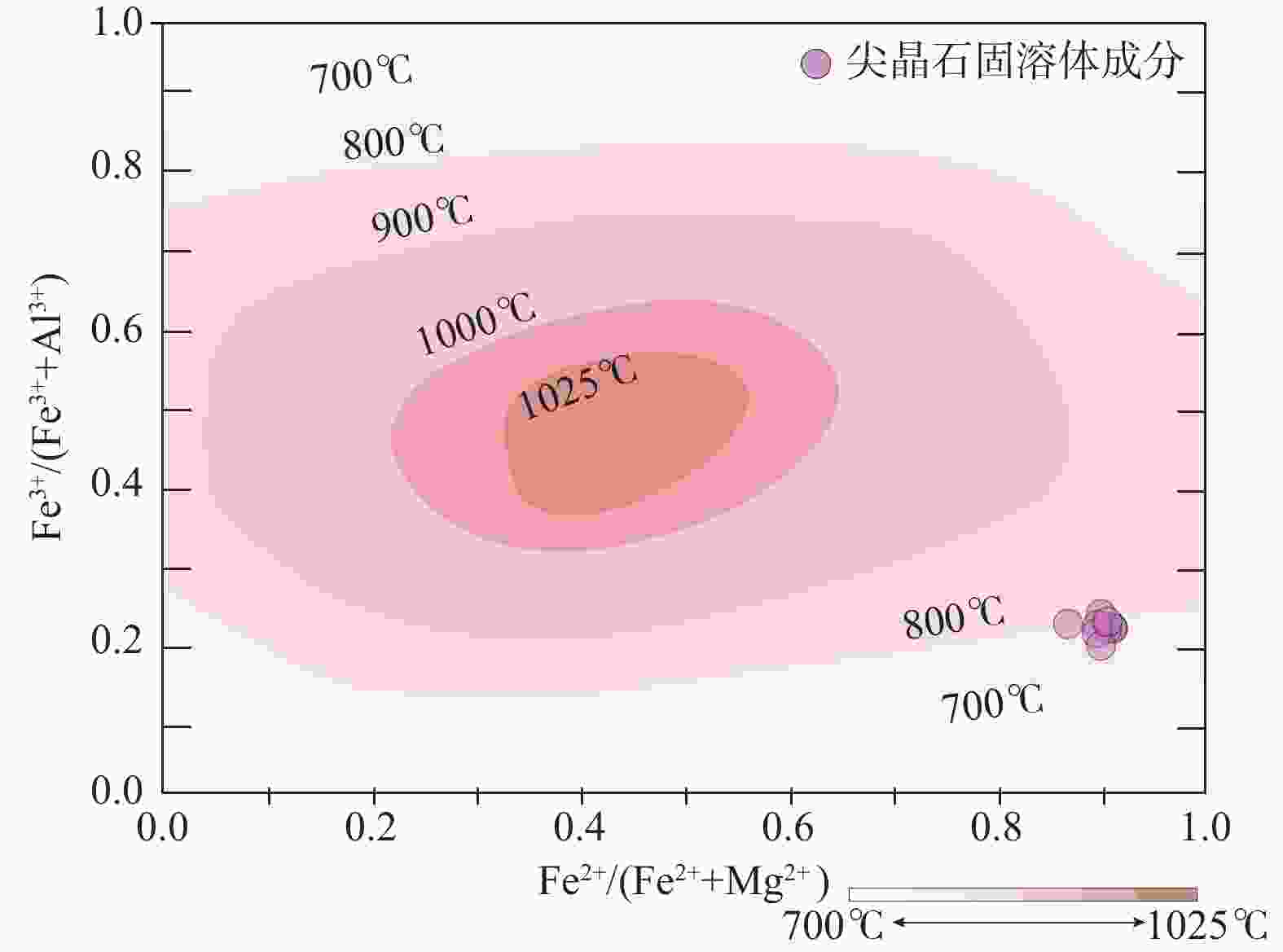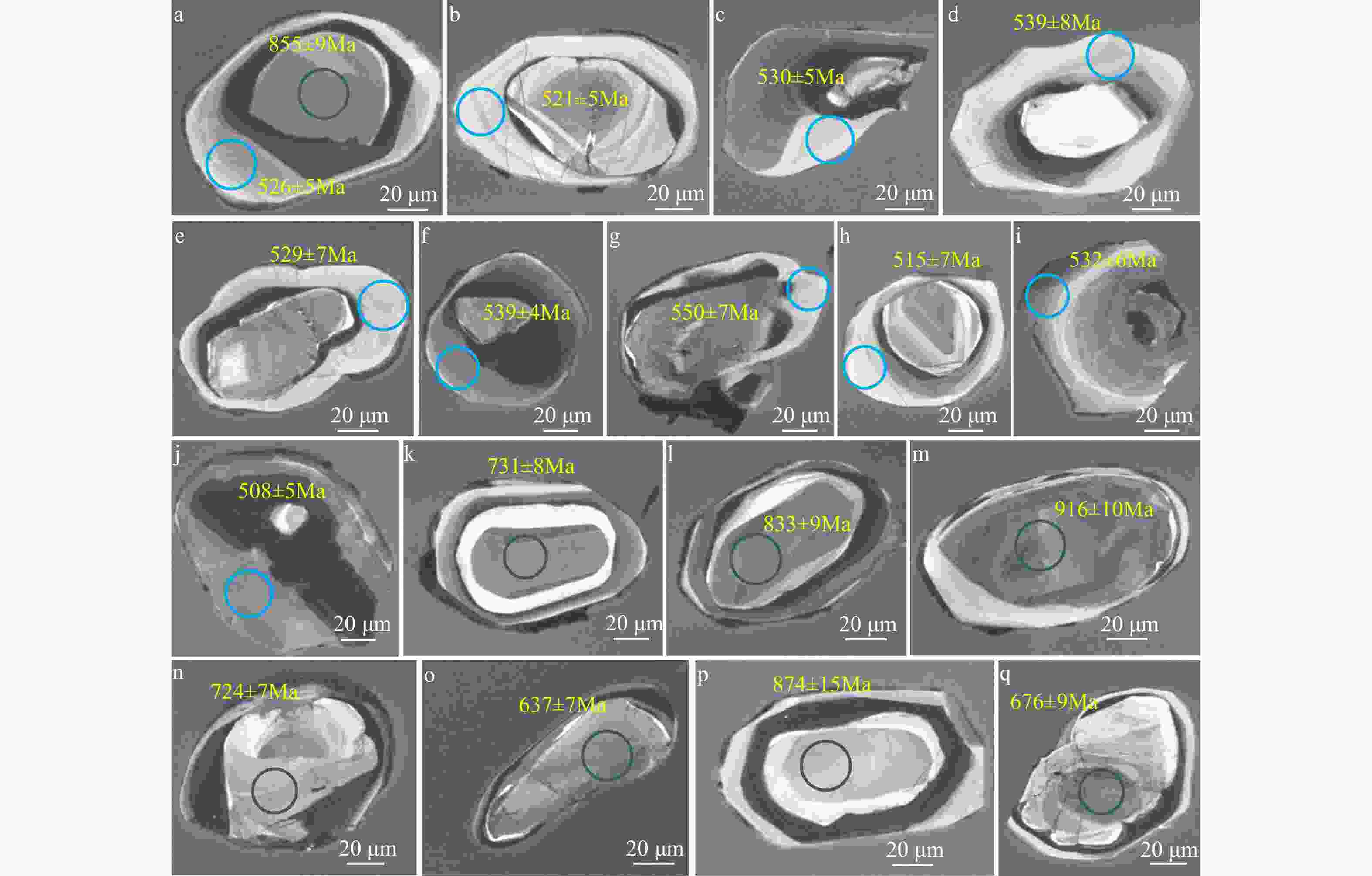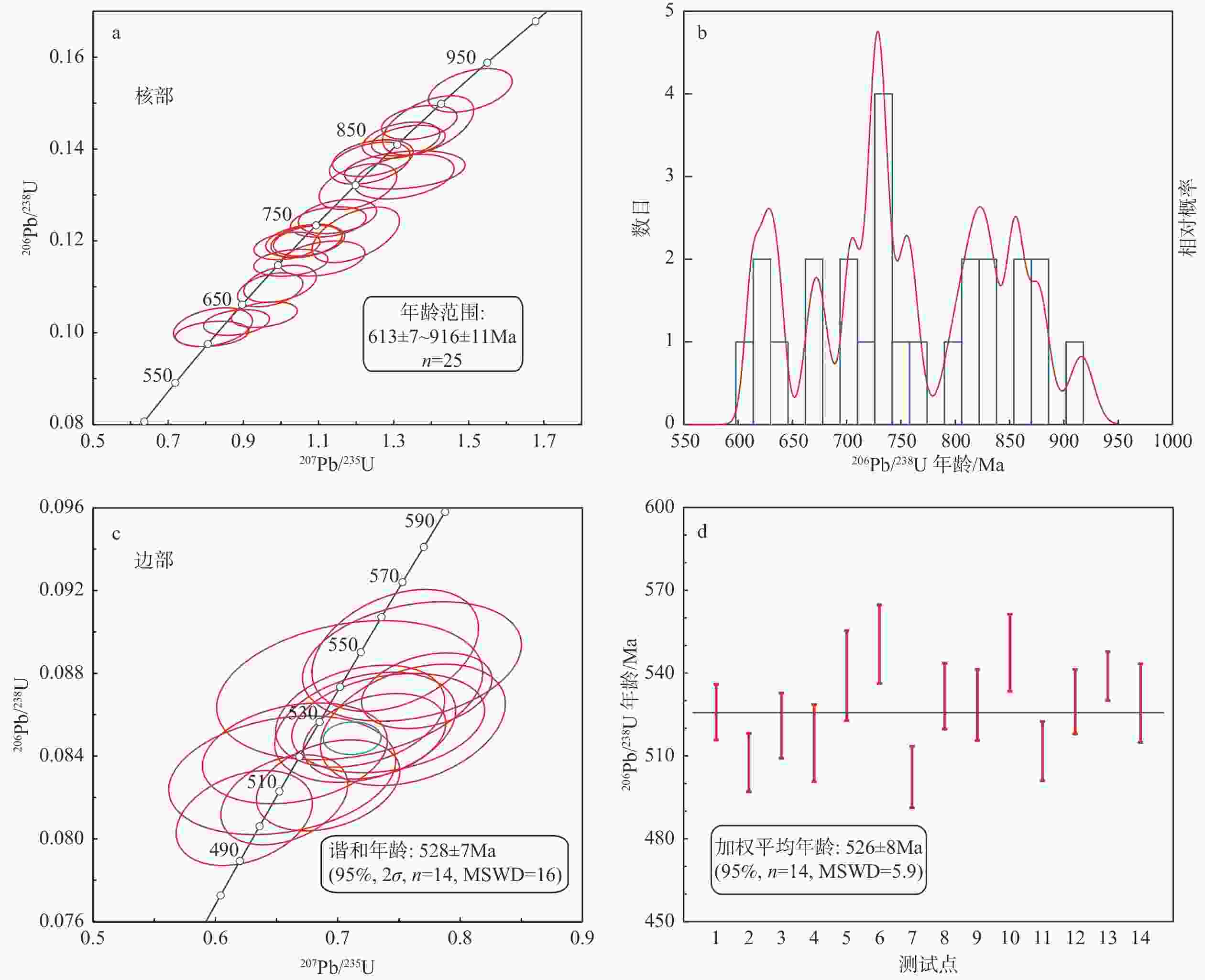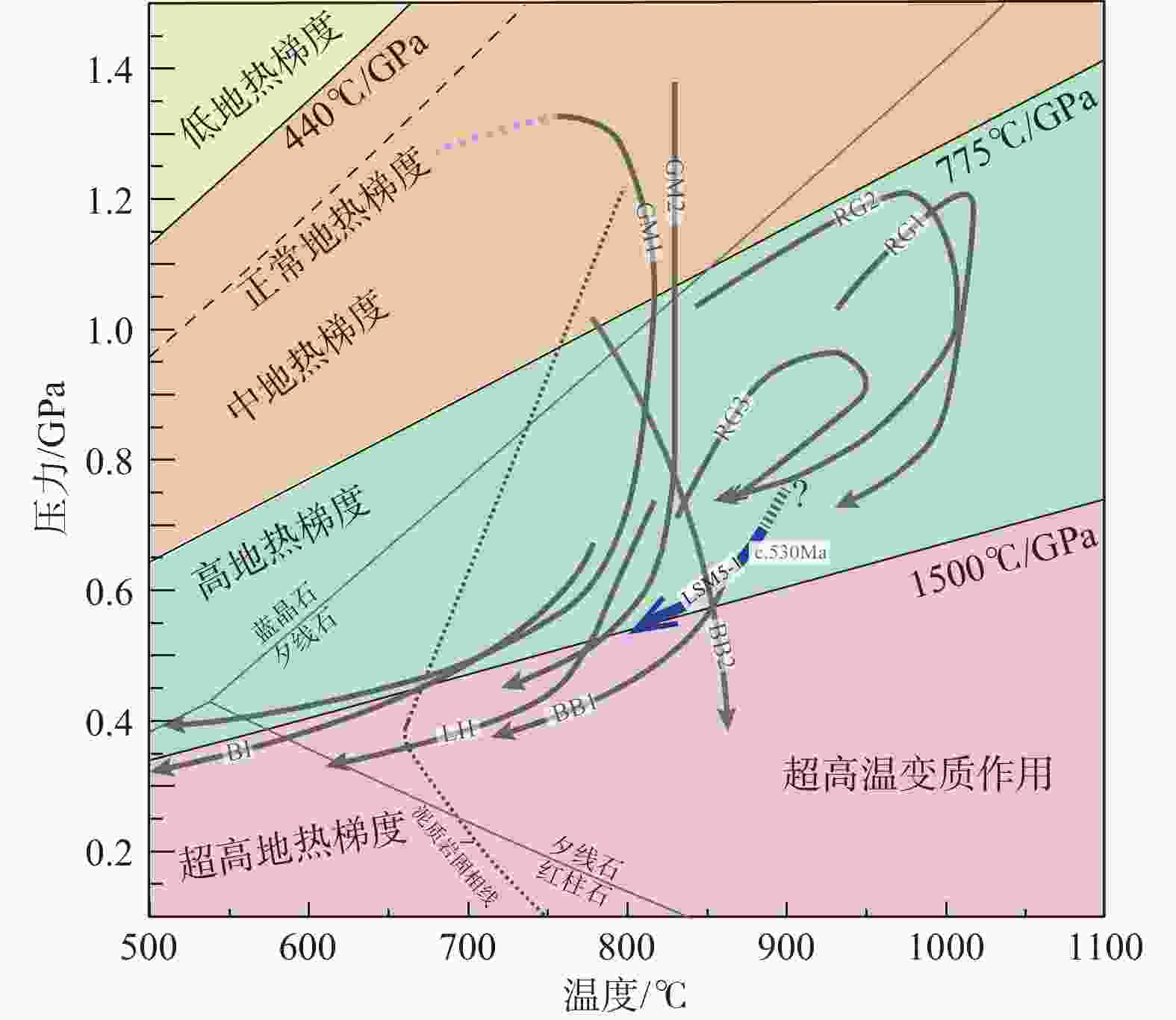Metamorphism and geochronology of the spinel−cordierite granulite in the Mirror Peninsula, East Antarctica
-
摘要: 东南极普里兹构造带被认为受到格林维尔期及泛非期两期构造热事件的影响,分别与罗迪尼亚和冈瓦纳超大陆的演化密切相关,但对两期构造热事件的性质还存在争议。为了进一步完善该构造带的演化历史,从矿物学、岩石学、相平衡模拟、锆石年代学等角度对普里兹构造带米洛半岛尖晶石−堇青石麻粒岩进行了研究。结果表明其主期矿物组合为尖晶石+堇青石+黑云母+矽线石+少量石榴子石+钾长石+钛铁矿,温压条件为870~910 ℃、0.64~0.69 GPa,晚期退变至810~820 ℃、0.49~0.53 GPa,并暗示了更高的峰期变质条件(T>910℃,P>0.69 GPa)。CL图像显示锆石具有明显的核−幔−边结构,LA−ICP−MS 锆石U–Pb年代学分析显示核部年龄主要集中在613±7 Ma到877±9 Ma,最大值916±11 Ma,比典型的格林维尔期年龄年轻。锆石边部加权平均年龄为526±8 Ma,其Th/U比值范围较大(0.06~1.23),多数Th/U比值较高(>0.1),应代表峰后冷却结晶阶段。尖晶石−堇青石麻粒岩记录了中低压/高温—超高温的变质条件,结合区域已有资料,可能具有顺时针轨迹,其变质演化历史可能反映了碰撞造山之后的伸展阶段,推测与冈瓦纳超大陆的聚合过程有关。
-
关键词:
- 东南极 /
- 尖晶石−堇青石麻粒岩 /
- P−T轨迹 /
- 高温—超高温变质 /
- 相平衡模拟
Abstract:Objective The Prydz Bay belt in East Antarctica recorded two significant tectono-thermal events, the Grenvillian event and the Pan-African event, which are considered to be closely related to the evolution of the Rodinia and Gondwana supercontinents. However, the geological history and the tectonic nature of the two events remain controversial. Methods Mineralogical and petrological analyses, phase equilibria modelling and zircon geochronology are combined to investigate the spinel−cordierite granulite from the Mirror Peninsula in order to better understand the tectono-thermal history of the Prydz Bay belt. Results The spinel−cordierite granulite contains different stages of mineral assemblages. The major stage of mineral assemblage involves cordierite, spinel, biotite, sillimanite, K-feldspar and minor garnet and ilmenite. The later stage of mineral assemblage is indicated by the emergence of magnetite as the increasing volumes of biotite and cordierite. Minor garnet and corundum are locally preserved, implying the mineral reaction ‘g+cor→sp+sill’ and more garnet and corundum in the peak stage. The garnet grains consist of 70%−72% almandine, 20%−22% pyrope, ~4% grossularite and ~4% spessartine. The XFe (Fe2+/(Fe2++Mg2+)) of representative garnet grains ranges from 0.77 to 0.80. The spinel exhibits an XFe range from 0.80 to 0.86. Different cordierite grains have similar compositions with Al of 3.89−3.93 a.p.f.u (atoms per formula unit) and XFe of 0.32−0.36. Biotite has high TiO2 (4.13%−5.23%) and Ti (0.23−0.30 a.p.f.u). K-feldspar grains consist of 78%−85% orthoclase, 15%−23% albite and ~1% anorthite. Based on the mineral compositions and phase equilibrium modelling, the pressure−temperature (P−T) conditions of the major stage of mineral assemblage are constrained to 870−910 °C and 0.64−0.69 GPa, followed by later retrogression to 810−820°C and 0.49−0.53 GPa. A peak stage with higher P−T conditions (T>910 ℃, P>0.69 GPa) can be inferred based on the relict peak minerals and characteristic mineral compositions (e.g. Ti in biotite). Zircon grains commonly show core-mantle-rim structures in cathodoluminescence (CL) images. The LA−ICP−MS zircon U−Pb dating analyses reveal a wide age range from 613±7 Ma to 877±9 Ma (except a maximum of 916±11 Ma) for the cores. The zircon bright rims yield a weighted mean age of 526±8 Ma with a wide range of Th/U (0.06−1.23), mostly higher than 0.1. Conclusion Based on the results, a few conclusions can be drawn: (1) The spinel−cordierite granulite recorded medium−low pressure/high-ultrahigh temperature metamorphism with a clockwise P−T evolution path and high dT/dP. (2) The results of zircon geochronological analysis show that zircon cores mainly record U−Pb ages in the range of 800~600 Ma, younger than typical ages of Grenvillian events, which may reflect younger inherited zircon cores or significant isotopic resetting. (3) The age of ~530 Ma of zircon rims is interpreted to represent the post-peak cooling stage of the Pan-African tectono-thermal event. [Significance] This study examined the P−T conditions and the zircon ages of the spinel−cordierite granulite in the Mirror Peninsula. In combination with previous results, the P−T−t path constructed for the spinel−cordierite granulite provides new constraints on the evolution of the Prydz Bay belt during the Pan-African period. -
图 1 普里兹构造带及拉斯曼丘陵米洛半岛区域地质简图
a—普里兹构造带示意图(据Grew et al.,2012修改);b—拉斯曼丘陵米洛半岛地质简图(据Carson et al.,2007修改)
Figure 1. Regional geological maps of the Prydz Bay belt and Mirror Peninsula in Larsemann Hills
(a) Schematic map of the Prydz Bay belt (modified after Grew et al., 2012); (b) Geological sketch map of Mirror Peninsula, Larsemann Hills (modified after Carson et al.,2007)
图 2 尖晶石−堇青石麻粒岩样品LSM5-1岩相学特征
g—石榴子石;bi—黑云母;ksp—钾长石;crd—堇青石;sp—尖晶石;sill—矽线石;mt—磁铁矿;pl—斜长石;cor—刚玉a—手标本照片;b—残留的石榴子石颗粒;c—尖晶石、黑云母与堇青石共生;d—矽线石呈长柱状产出;e—尖晶石、磁铁矿与刚玉共生;f—尖晶石出溶磁铁矿;g—钾长石出溶细小斜长石条带;h—黑云母作为尖晶石的包裹体产出
Figure 2. Petrographic characteristics of spinel-cordierite granulite sample LSM5-1
(a) Photograph of the hand specimen; (b) Residual garnet grains; (c) Paragenetic mineral assemblages: spinel, biotite and cordierite; (d) Columnar sillimanite; (e) Paragenetic mineral assemblages of spinel, magnetite and corundum; (f) Dissolved magnetite in spinel; (g) Exsolution texture of plagioclase in k-feldspar; (h) Biotite occurs as inclusions in spinel g−garnet; bi−biotite; ksp−k-feldspar; crd−cordierite; sp−spinel; sill−sillimanite; mt−magnetite; pl−plagioclase; cor−corundum
图 3 尖晶石−堇青石麻粒岩样品LSM5-1石榴子石成分剖面图(g1、g2为两个不同的石榴子石颗粒)
注:Alm=Fe2+/(Fe2++Mg+Mn+Ca);Py=Mg/(Fe2++Mg+Mn+Ca);Gr=Ca/(Fe2++Mg+Mn+Ca);Spss=Mn/(Fe2++Mg+Mn+Ca)
Figure 3. Compositional profile of garnet in spinel–cordierite granulite sample LSM5-1 (a and b are two different garnet grains)
Note: Alm=Fe2+/(Fe2++Mg+Mn+Ca); Py=Mg/(Fe2++Mg+Mn+Ca); Gr=Ca/(Fe2++Mg+Mn+Ca); Spss=Mn/(Fe2++Mg+Mn+Ca)
图 4 尖晶石−堇青石麻粒岩样品LSM5-1尖晶石族矿物分类图解(据Deer et al.,1992修改)
Figure 4. Classification diagram of the spinel group minerals of spinel–cordierite granulite sample LSM5-1(modified from Deer et al.,1992)
图 5 尖晶石−堇青石麻粒岩样品LSM5-1云母分类图解(底图据Foster,1960修改)
Figure 5. Classification diagram of micas of spinel–cordierite granulite sample LSM5-1 (base map modified after Foster,1960)
图 6 尖晶石−堇青石麻粒岩样品LSM5-1在MnNCKFMASHTO体系下模拟T−$x_{{\mathrm{H}}_2 {\mathrm{O}}} $与P−T视剖面图及等值线
a—样品T−$x_{{\mathrm{H}}_2 {\mathrm{O}}} $模拟图;b—样品P−T模拟图;c—不同矿物转变线(堇青石、石榴子石、黑云母)及黑云母Ti成分等值线;d—石榴子石镁铝榴石成分等值线、黑云母Ti成分等值线
Figure 6. T−$x_{{\mathrm{H}}_2 {\mathrm{O}}} $ and P−T pseudosections and composition isopleths for spinel−cordierite granulite sample LSM5-1 in system MnNCKFMASHTO
(a) T–$x_{{\mathrm{H}}_2 {\mathrm{O}}} $ pseudosection; (b) P–T pseudosection; (c) Different mineral transformation curves (cordierite, garnet, biotite) and mineral composition isopleths of Ti (bi); (d) Mineral composition isopleths of Py and Ti (bi)
图 7 尖晶石单矿物温度计(底图据Sack and Ghiorso,1991修改)
Figure 7. Calculated miscibility gaps for spinel (Base map modified from Sack and Ghiorso,1991)
图 9 尖晶石−堇青石麻粒岩样品LSM5-1锆石U−Pb年代学相关图解
a—核部年龄范围;b—核部年龄分布;c—边部谐和年龄;d—边部加权平均年龄
Figure 9. Correlation diagrams of zircon U-Pb ages in spinel-cordierite granulite sample LSM5-1
(a) Age range of zircon cores; (b) Distribution of U-Pb age; (c) Concordia age of zircon rims; (d) Weighted average age of zircon rims
图 11 普里兹构造带及其邻区岩石变质P−T轨迹(据Wang et al.,2022修改)
LH—拉斯曼丘陵基性和泥质麻粒岩(Carson et al.,1997);GM1—格罗夫山基性麻粒岩(Liu et al.,2009a);GM2—格罗夫山高压变质岩(Chen et al.,2018);RG1&RG3—茹尔群岛中马瑟副片麻岩(Harley et al.,1998;Kelsey et al.,2007);RG2—茹尔群岛中基性麻粒岩(Tong and Wilson,2006);BB1—布拉特滨海陡崖的片麻岩(Fitzsimons,1996);BB2—布拉特滨海陡崖的泥质麻粒岩(Arora et al.,2020);BI—伯灵恩群岛的钙硅酸岩(Motoyoshi et al.,1991);c.530 Ma代表年龄为530 Ma左右。
Figure 11. Metamorphic P−T path from samples in Prydz Bay belt and adjacent regions (modified from Wang et al.,2022)
LH–mafic granulite and pelitic granulite in Larsemann Hills (Carson et al.,1997); GM1–mafic granulite in Grove Mountains (Liu et al.,2009a); GM2–HP(high-pressure) metapelite in Grove Mountains (Chen et al.,2018); RG1&RG3–Mg-Al-rich Mather paragneiss in Rauer Group (Harley et al.,1998;Kelsey et al.,2007); RG2–Mafic granulite in Rauer Group (Tong and Wilson,2006); BB1–Paragneiss in Brattstrand Bluffs (Fitzsimons,1996); BB2–Pelitic granulite in Brattstrand Bluffs (Arora et al.,2020); BI–Calc-silicates in Bolingen Islands (Motoyoshi et al.,1991)
表 1 米洛半岛尖晶石−堇青石麻粒岩LSM5-1代表性石榴子石电子探针数据/%
Table 1. EPMA data of representative garnet of spinel–cordierite granulite sample LSM5-1 in the Mirror Peninsula (%)
矿物 g1-1 g1-2 g1-3 g1-4 g1-5 g1-6 g1-7 g1-8 g1-9 g1-10 g1-11 g1-12 g2-1 g2-2 g2-3 g2-4 g2-5 g2-6 g2-7 g2-8 g2-9 g2-10 g2-11 g2-12 SiO2 36.87 36.41 36.23 35.88 35.86 35.84 35.78 35.52 36.06 36.1 36.19 36.48 36.28 36.29 36.09 36.29 35.65 36.67 35.8 35.67 35.98 36.95 35.80 35.80 TiO2 0 0 0.04 0 0.01 0 0 0 0.04 0.02 0 0 0.01 0.01 0.02 0.03 0 0.01 0 0.01 0 0.01 0.03 0.06 Al2O3 22.14 21.97 22.11 22.07 22.24 21.87 22.1 22.16 22.05 21.82 21.76 22.06 21.51 21.94 21.57 22.00 22.25 21.62 21.97 21.85 21.88 20.79 21.88 22.32 Cr2O3 0 0.04 0.02 0.04 0.04 0.04 0 0.03 0.02 0.02 0 0.05 0.01 0.01 0.05 0 0.07 0.05 0.02 0.02 0.03 0.04 0.03 0 Fe2O3 1.53 1.97 1.99 3.01 3.49 3.65 3.32 3.83 2.65 3.42 3.55 1.96 2.89 1.87 3.23 1.62 3.17 1.77 3.52 4.28 3.40 1.54 3.10 2.63 FeO 31.47 30.88 31.04 30.35 30.05 30.05 30.11 29.86 30.40 29.94 30.17 30.87 31.07 31.50 31.53 31.60 30.44 31.77 30.76 30.06 30.45 32.13 30.67 30.98 MnO 1.80 1.75 1.76 1.79 1.72 1.79 1.87 1.78 1.76 1.87 1.74 1.83 1.86 1.93 1.81 1.86 1.87 1.68 1.89 1.98 1.87 1.92 1.88 1.87 MgO 5.03 5.10 4.83 4.93 4.99 5.07 5.07 5.22 5.11 5.41 5.37 5.16 4.77 4.59 4.40 4.62 4.72 4.83 4.72 4.89 5.00 4.73 4.77 4.61 CaO 1.24 1.23 1.26 1.32 1.30 1.24 1.20 1.08 1.20 1.21 1.20 1.22 1.22 1.30 1.22 1.17 1.28 1.19 1.16 1.21 1.13 1.19 1.23 1.30 Na2O 0.05 0.04 0.06 0.05 0.12 0.08 0.05 0.02 0.07 0.04 0.05 0.03 0.08 0.02 0.08 0.05 0.05 0.05 0.05 0.07 0.07 0.04 0.04 0.02 K2O 0 0.02 0.01 0.01 0 0 0 0.01 0 0 0 0 0.01 0 0.02 0 0 0 0 0 0 0 0 0 Total 100.14 99.39 99.34 99.43 99.82 99.61 99.49 99.51 99.36 99.84 100.02 99.66 99.70 99.46 100.01 99.21 99.50 99.64 99.90 100.04 99.80 99.34 99.41 99.58 O 12.00 12.00 12.00 12.00 12.00 12.00 12.00 12.00 12.00 12.00 12.00 12.00 12.00 12.00 12.00 12.00 12.00 12.00 12.00 12.00 12.00 12.00 12.00 12.00 Si 2.92 2.91 2.90 2.87 2.86 2.87 2.86 2.84 2.88 2.87 2.88 2.91 2.90 2.91 2.90 2.91 2.86 2.93 2.86 2.85 2.87 2.97 2.87 2.87 Ti 0 0 0 0 0 0 0 0 0 0 0 0 0 0 0 0 0 0 0 0 0 0 0 0 Al 2.07 2.07 2.09 2.08 2.09 2.06 2.08 2.09 2.08 2.05 2.04 2.07 2.03 2.07 2.04 2.08 2.10 2.04 2.07 2.06 2.06 1.97 2.07 2.11 Cr 0 0 0 0 0 0 0 0 0 0 0 0 0 0 0 0 0 0 0 0 0 0 0 0 Fe3+ 0.09 0.12 0.12 0.18 0.21 0.22 0.20 0.23 0.16 0.21 0.21 0.14 0.17 0.11 0.20 0.10 0.19 0.11 0.21 0.26 0.20 0.09 0.19 0.16 Fe2+ 2.09 2.06 2.08 2.03 2.00 2.01 2.01 2.00 2.03 1.99 2.01 2.06 2.08 2.11 2.11 2.12 2.04 2.12 2.06 2.01 2.03 2.16 2.06 2.07 Mn 0.12 0.12 0.10 0.12 0.12 0.12 0.13 0.12 0.12 0.13 0.12 0.12 0.13 0.13 0.12 0.13 0.13 0.11 0.13 0.13 0.13 0.13 0.13 0.13 Mg 0.59 0.61 0.58 0.59 0.59 0.60 0.61 0.62 0.61 0.64 0.64 0.61 0.57 0.55 0.53 0.55 0.56 0.58 0.56 0.58 0.60 0.57 0.57 0.55 Ca 0.11 0.11 0.11 0.11 0.11 0.11 0.10 0.09 0.10 0.10 0.10 0.10 0.10 0.11 0.11 0.10 0.11 0.10 0.10 0.10 0.10 0.10 0.11 0.11 Na 0.01 0.01 0.01 0.01 0.02 0.01 0.01 0 0.01 0.01 0.01 0 0.01 0 0.01 0.01 0.01 0.01 0.01 0.01 0.01 0.01 0.01 0 K 0 0 0 0 0 0 0 0 0 0 0 0 0 0 0 0 0 0 0 0 0 0 0 0 Sum 8.00 8.00 8.00 8.00 8.00 8.00 8.00 8.00 8.00 8.00 8.00 8.00 8.00 8.00 8.00 8.00 8.00 8.00 8.00 8.00 8.00 8.00 8.00 8.00 XFe 0.78 0.77 0.78 0.78 0.77 0.77 0.77 0.76 0.77 0.76 0.76 0.77 0.79 0.79 0.80 0.79 0.78 0.79 0.79 0.78 0.77 0.79 0.78 0.79 Gr 0.04 0.04 0.04 0.04 0.04 0.04 0.04 0.03 0.04 0.04 0.04 0.04 0.04 0.04 0.04 0.03 0.04 0.04 0.04 0.04 0.03 0.03 0.04 0.04 Spss 0.04 0.04 0.04 0.04 0.04 0.04 0.04 0.04 0.04 0.04 0.04 0.04 0.04 0.05 0.04 0.04 0.04 0.04 0.04 0.05 0.04 0.04 0.04 0.04 Py 0.20 0.21 0.20 0.21 0.21 0.21 0.21 0.22 0.21 0.22 0.22 0.21 0.20 0.19 0.18 0.19 0.20 0.20 0.20 0.21 0.21 0.19 0.20 0.19 Alm 0.72 0.71 0.72 0.71 0.71 0.71 0.71 0.70 0.71 0.70 0.70 0.71 0.72 0.73 0.74 0.73 0.72 0.73 0.72 0.71 0.71 0.73 0.72 0.72 注:XFe=Fe2+/(Fe2++Mg) 表 2 米洛半岛尖晶石−堇青石麻粒岩LSM5-1代表性尖晶石与磁铁矿矿物电子探针数据/%
Table 2. EPMA data of representative spinel and magnetite of spinel–cordierite granulite sample LSM5-1 in the Mirror Peninsula (%)
矿物 sp-1 sp-2 sp-3 sp-4 sp-5 sp-6 sp-7 sp-8 sp-9 sp-10 mt-1 mt-2 mt-3 mt-4 mt-5 mt-6 mt-7 mt-8 mt-9 mt-10 SiO2 0.03 0 0 0.03 0 0.01 0.01 0.01 0.01 0.01 0.02 0 0.01 0.01 0.01 0.04 0.21 0.01 0 0.03 TiO2 0.03 0.03 0.03 0 0 0 0.01 0.01 0.01 0.01 0.01 0.04 0.05 0.01 0.03 0.01 0 0 0.15 0.06 Al2O3 55.05 55.52 55.61 54.51 55.87 55.96 55.51 55.43 54.85 55.22 3.10 1.11 1.47 0.18 0.90 0.17 0.54 2.72 8.86 0.26 Cr2O3 0.17 0.22 0.21 0.20 0.17 0.20 0.23 0.21 0.23 0.18 0.14 0.14 0.15 0.15 0.16 0.14 0.24 0.13 0.19 0.17 Fe2O3 5.70 5.02 5.37 6.81 5.12 5.45 5.43 5.20 6.06 5.79 65.46 67.30 65.28 67.98 67.86 68.72 67.14 65.76 59.07 68.27 FeO 35.62 35.07 35.58 34.85 35.21 33.58 34.83 34.68 35.03 35.12 31.27 30.96 30.22 30.74 31.20 30.90 30.96 31.02 31.90 31.15 MnO 0.21 0.25 0.21 0.23 0.27 0.27 0.22 0.24 0.25 0.25 0 0.03 0 0 0.01 0.03 0 0 0 0 MgO 3.22 3.44 3.35 3.68 3.52 4.58 3.74 3.69 3.49 3.50 0.23 0.12 0.11 0 0.06 0 0.11 0.28 0.65 0.02 CaO 0 0 0 0 0 0 0 0 0 0 0 0 0 0 0 0 0 0 0 0 Na2O 0.01 0.02 0 0 0 0 0 0 0 0 0.01 0 0.03 0.01 0 0.05 0 0.01 0.02 0 K2O 0 0 0 0 0 0 0 0.01 0 0.01 0.01 0 0 0 0 0 0.01 0 0.01 0 ZnO 0.23 0.13 0.11 0.14 0.09 0 0.14 0.11 0.12 0.14 0.02 0.16 0.01 0 0 0 0 0.04 0 0.01 Total 100.27 99.70 100.47 100.45 100.25 100.05 100.12 99.59 100.05 100.23 100.27 99.86 97.33 99.08 100.23 100.06 99.21 99.97 100.85 99.97 O 4.00 4.00 4.00 4.00 4.00 4.00 4.00 4.00 4.00 4.00 4.00 4.00 4.00 4.00 4.00 4.00 4.00 4.00 4.00 4.00 Si 0 0 0 0 0 0 0 0 0 0 0 0 0 0 0 0 0.01 0 0 0 Ti 0 0 0 0 0 0 0 0 0 0 0 0 0 0 0 0 0 0 0 0 Al 1.87 1.89 1.88 1.85 1.89 1.88 1.88 1.88 1.86 1.87 0.14 0.05 0.07 0.01 0.04 0.01 0.03 0.12 0.38 0.01 Cr 0 0.01 0.01 0.01 0 0.01 0.01 0.01 0.01 0 0 0 0.01 0.01 0.01 0 0.01 0 0.01 0.01 Fe3+ 0.12 0.11 0.12 0.15 0.11 0.12 0.12 0.11 0.13 0.13 1.86 1.94 1.93 1.99 1.95 1.99 1.95 1.88 1.61 1.98 Fe2+ 0.86 0.85 0.85 0.84 0.84 0.80 0.84 0.84 0.84 0.84 0.99 0.99 0.99 1.00 1.00 0.99 1.00 0.98 0.97 1.00 Mn 0.01 0.01 0.01 0.01 0.01 0.01 0.01 0.01 0.01 0.01 0 0 0 0 0 0 0 0 0 0 Mg 0.14 0.15 0.14 0.16 0.15 0.19 0.16 0.16 0.15 0.15 0.01 0.01 0.01 0 0 0 0.01 0.02 0.04 0 Ca 0 0 0 0 0 0 0 0 0 0 0 0 0 0 0 0 0 0 0 0 Na 0 0 0 0 0 0 0 0 0 0 0 0 0 0 0 0 0 0 0 0 K 0 0 0 0 0 0 0 0 0 0 0 0 0 0 0 0 0 0 0 0 Sum 3.00 3.00 3.00 3.00 3.00 3.00 3.00 3.00 3.00 3.00 3.00 3.00 3.00 3.00 3.00 3.00 3.00 3.00 3.00 3.00 表 3 米洛半岛尖晶石−堇青石麻粒岩LSM5-1代表性黑云母电子探针数据/%
Table 3. EPMA data of representative biotite of spinel–cordierite granulite sample LSM5-1 in the Mirror Peninsula (%)
矿物 bi-1 bi-2 bi-3 bi-4 bi-5 bi-6 bi-7 bi-8 bi-9 bi-10 bi-11 bi-12 SiO2 36.91 36.63 35.77 37.12 35.69 36.96 37.07 35.78 35.8 35.78 36.05 35.52 TiO2 4.36 4.13 4.03 5.21 5.23 5.08 4.86 4.94 4.72 5.10 4.86 4.85 Al2O3 15.20 14.93 15.11 14.61 14.78 14.4 14.65 14.84 15.06 14.65 14.69 14.86 Cr2O3 0.01 0.06 0.04 0.02 0.04 0.05 0.02 0.02 0.06 0.11 0.09 0.10 Fe2O3 0 0 0 0 0 0 0 0 0 0 0 0 FeO 15.83 15.89 17.79 18.47 19.54 18.82 18.42 18.51 18.19 18.13 17.80 18.57 MnO 0.05 0.05 0.03 0.02 0.03 0.06 0.07 0.11 0.05 0.08 0.08 0.09 MgO 12.71 12.64 12.66 10.55 10.23 10.36 10.53 11.13 11.51 11.15 11.50 11.35 CaO 0 0 0 0 0 0 0 0.02 0.05 0.06 0.06 0.04 Na2O 0.37 0.37 0.18 0.13 0.14 0.13 0.20 0.20 0.21 0.22 0.20 0.20 K2O 9.70 10.14 9.88 9.81 9.70 9.93 9.87 9.96 9.82 9.82 9.83 9.84 Total 95.12 94.84 95.48 95.95 95.40 95.80 95.69 95.53 95.46 95.10 95.17 95.41 O 11.00 11.00 11.00 11.00 11.00 11.00 11.00 11.00 11.00 11.00 11.00 11.00 Si 2.78 2.78 2.72 2.81 2.74 2.81 2.81 2.73 2.73 2.74 2.75 2.72 Ti 0.25 0.24 0.23 0.30 0.30 0.29 0.28 0.28 0.27 0.29 0.28 0.28 Al 1.35 1.34 1.36 1.30 1.34 1.29 1.31 1.34 1.35 1.32 1.32 1.34 Cr 0 0 0 0 0 0 0 0 0 0.01 0.01 0.01 Fe3+ 0 0 0 0 0 0 0 0 0 0 0 0 Fe2+ 1.00 1.01 1.13 1.17 1.25 1.20 1.17 1.18 1.16 1.16 1.14 1.19 Mn 0 0 0 0 0 0 0 0.01 0 0.01 0.01 0.01 Mg 1.43 1.43 1.44 1.19 1.17 1.17 1.19 1.27 1.31 1.27 1.31 1.29 Ca 0 0 0 0 0 0 0 0 0 0.01 0.01 0 Na 0.05 0.05 0.03 0.02 0.02 0.02 0.03 0.03 0.03 0.03 0.03 0.03 K 0.93 0.98 0.96 0.95 0.95 0.96 0.96 0.97 0.96 0.96 0.96 0.96 Sum 7.79 7.83 7.86 7.73 7.78 7.75 7.75 7.82 7.82 7.80 7.80 7.83 XMg 0.59 0.59 0.56 0.50 0.48 0.50 0.50 0.52 0.53 0.52 0.54 0.52 XFe 0.41 0.41 0.44 0.50 0.52 0.50 0.50 0.48 0.47 0.48 0.46 0.48 注:XMg=Mg/(Fe2++Mg);XFe=Fe2+/(Fe2++Mg) 表 4 米洛半岛尖晶石−堇青石麻粒岩LSM5-1代表性堇青石、钾长石电子探针数据/%
Table 4. EPMA data of representative cordierite and k-feldspar of spinel–cordierite granulite sample LSM5-1 in the Mirror Peninsula (%)
矿物 crd-1 crd-2 crd-3 crd-4 ksp-1 ksp-2 ksp-3 ksp-4 SiO2 49.42 49.07 49.53 48.78 64.82 64.55 65.06 64.03 TiO2 0 0.01 0 0 0.08 0 0.08 0.06 Al2O3 32.31 32.27 32.17 32.43 18.48 18.12 18.32 18.38 Cr2O3 0.01 0.06 0 0 0 0 0.03 0 Fe2O3 0 0.06 0 0.89 0.04 0.22 0.05 0.67 FeO 8.34 8.32 8.45 7.48 0 0 0 0 MnO 0.12 0.14 0.13 0.08 0 0.01 0 0 MgO 8.08 8.27 8.14 8.77 0 0.08 0.03 0.02 CaO 0.01 0.03 0.02 0 0.11 0.14 0.18 0.11 Na2O 0.08 0.12 0.06 0.03 1.90 1.93 2.42 1.69 K2O 0 0.02 0 0.01 14.34 14.23 13.4 14.39 Total 98.38 98.36 98.5 98.48 99.77 99.27 99.57 99.34 O 18.00 18.00 18.00 18.00 8.00 8.00 8.00 8.00 Si 5.08 5.05 5.08 5.01 2.99 2.99 2.99 2.97 Ti 0 0 0 0 0 0 0 0 Al 3.91 3.92 3.89 3.93 1.00 0.99 0.99 1.01 Cr 0 0 0 0 0 0 0 0 Fe3+ 0 0.01 0 0.07 0 0.01 0 0.02 Fe2+ 0.72 0.72 0.73 0.64 0 0 0 0 Mn 0.01 0.01 0.01 0.01 0 0 0 0 Mg 1.24 1.27 1.25 1.34 0 0.01 0 0 Ca 0 0 0 0 0.01 0.01 0.01 0.01 Na 0.02 0.02 0.01 0.01 0.17 0.17 0.22 0.15 K 0 0 0 0 0.84 0.84 0.79 0.85 Sum 10.97 11.00 10.98 11.00 5.01 5.02 5.01 5.01 表 5 锆石LA-ICP-MS测试结果
Table 5. Zircon LA-ICP-MS data
样品点 Th U Th/U 207Pb/206Pb 207Pb/235U 206Pb/238U 207Pb/206Pb 207Pb/235U 206Pb/238U ×10−6 比值 ±1σ 比值 ±1σ 比值 ±1σ 年龄/Ma ±1σ 年龄/Ma ±1σ 年龄/Ma ±1σ LSM5-1-核部 C-01 21 281 0.08 0.0654 0.0022 1.2051 0.0422 0.1318 0.0020 787 69 803 19 798 12 C-02 27 317 0.08 0.0678 0.0021 1.3390 0.0400 0.1418 0.0014 863 64 863 17 855 8 C-03 13 210 0.06 0.0642 0.0026 1.0265 0.0403 0.1152 0.0012 750 85 717 20 703 7 C-04 37 245 0.15 0.0668 0.0022 1.3200 0.0421 0.1419 0.0016 831 67 854 18 855 9 C-05 23 273 0.08 0.0659 0.0025 0.9560 0.0359 0.1039 0.0011 1200 79 681 19 637 7 C-06 45 257 0.17 0.0645 0.0024 0.9978 0.0395 0.1106 0.0017 759 78 703 20 676 10 C-07 38 135 0.28 0.0587 0.0028 0.8168 0.0400 0.0997 0.0011 554 101 606 22 613 7 C-08 39 160 0.25 0.0617 0.0023 1.0162 0.0360 0.1189 0.0012 661 75 712 18 724 7 C-09 33 112 0.30 0.0703 0.0033 1.3298 0.0655 0.1354 0.0017 1000 98 859 29 819 10 C-10 59 235 0.25 0.0647 0.0023 1.2448 0.0439 0.1380 0.0016 765 69 821 20 833 9 C-11 71 316 0.23 0.0673 0.0020 1.3682 0.0412 0.1458 0.0015 850 63 875 18 877 9 C-12 38 217 0.17 0.0654 0.0024 1.2366 0.0440 0.1369 0.0019 787 77 817 20 827 11 C-13 24 232 0.10 0.0646 0.0023 1.0751 0.0388 0.1200 0.0014 761 75 741 19 731 8 C-14 25 219 0.11 0.0624 0.0025 0.8818 0.0358 0.1022 0.0011 687 79 642 19 627 7 C-15 23 249 0.09 0.0645 0.0023 0.9714 0.0356 0.1093 0.0015 767 76 689 18 669 9 C-16 51 230 0.22 0.0657 0.0024 1.1262 0.0412 0.1241 0.0013 798 76 766 20 754 8 C-17 32 180 0.18 0.0671 0.0026 1.1508 0.0426 0.1253 0.0015 839 77 778 20 761 9 C-18 50 92 0.54 0.0591 0.0031 0.8192 0.0429 0.1012 0.0017 572 113 608 24 621 10 C-19 44 213 0.21 0.0644 0.0023 1.0682 0.0387 0.1200 0.0015 754 76 738 19 731 9 C-20 46 651 0.07 0.0707 0.0020 1.5039 0.0455 0.1528 0.0019 948 59 932 19 916 11 C-21 42 299 0.14 0.0689 0.0023 1.3918 0.0496 0.1451 0.0026 894 64 885 22 874 15 C-22 17 128 0.13 0.0690 0.0028 1.1107 0.0461 0.1161 0.0016 898 89 758 22 708 9 C-23 28 151 0.19 0.0639 0.0026 1.0613 0.0414 0.1200 0.0014 739 90 734 20 730 8 C-24 41 227 0.18 0.0711 0.0026 1.1991 0.0475 0.1213 0.0025 959 74 800 22 738 14 C-25 30 114 0.26 0.0713 0.0030 1.3275 0.0546 0.1340 0.0020 965 87 858 24 811 11 LSM5-1-边部 Rr-01 107 358 0.30 0.0621 0.0021 0.7302 0.0238 0.0850 0.0008 680 72 557 14 526 5 Rr-06 52 518 0.10 0.0579 0.0019 0.6565 0.0212 0.0819 0.0009 524 72 512 13 508 5 Rr-08 125 153 0.82 0.0566 0.0025 0.6652 0.0309 0.0842 0.0010 476 98 518 19 521 6 Rr-10 131 107 1.23 0.0577 0.0034 0.6548 0.0379 0.0831 0.0012 517 127 511 23 515 7 Rr-15 119 104 1.14 0.0580 0.0036 0.7099 0.0444 0.0872 0.0014 532 137 545 26 539 8 Rr-05 73 363 0.20 0.0607 0.0024 0.7472 0.0278 0.0891 0.0012 629 84 567 16 550 7 Rr-07 110 293 0.37 0.0554 0.0020 0.6238 0.0227 0.0810 0.0009 428 82 492 14 502 6 Rr-09 129 282 0.46 0.0605 0.0024 0.7184 0.0282 0.0860 0.0010 633 53 550 17 532 6 Rr-12 122 202 0.60 0.0614 0.0027 0.7226 0.0302 0.0854 0.0011 654 95 552 18 528 7 Rr-13 100 181 0.55 0.0620 0.0029 0.7608 0.0366 0.0886 0.0012 672 102 574 21 547 7 Rr-14 85 368 0.23 0.0606 0.0022 0.6923 0.0239 0.0826 0.0009 633 79 534 14 512 5 Rr-04 96 267 0.36 0.0629 0.0030 0.7414 0.0322 0.0856 0.0010 706 294 563 19 530 6 Rr-03 46 760 0.06 0.0640 0.0019 0.7729 0.0218 0.0872 0.0007 743 262 581 13 539 4 Rr-02 157 150 1.05 0.0653 0.0029 0.7636 0.0309 0.0855 0.0012 787 88 576 18 529 7 -
[1] ARORA D, PANT N, PANDEY M, et al, 2020. Insights into geological evolution of Princess Elizabeth Land, East Antarctica-clues for continental suturing and breakup since Rodinian time[J]. Gondwana Research, 84: 260-283. doi: 10.1016/j.gr.2020.05.002 [2] BIAO X, WANG W, WU J, et al, 2022. Ultra-high temperature metamorphism in the Prydz Bay region, East Antarctica[J]. Chinese Journal of Polar Research, 34(4): 516-529. (in Chinese with English abstract [3] BROWN M, 2007. Metamorphic conditions in orogenic belts: A record of secular change[J]. International Geology Review, 49(3): 193-234. doi: 10.2747/0020-6814.49.3.193 [4] BROWN M, JOHNSON T, 2018. Secular change in metamorphism and the onset of global plate tectonics[J]. American Mineralogist, 103(2): 181-196. doi: 10.2138/am-2018-6166 [5] CARSON C J, FANNING C M, WILSON C J L, 1996. Timing of the Progress Granite, Larsemann Hills: additional evidence for early Palaeozoic orogenesis within the east Antarctic Shield and implications for Gondwana assembly[J]. Australian Journal of Earth Sciences, 43(5): 539-553. doi: 10.1080/08120099608728275 [6] CARSON C J, POWELL R, WILSON C J L, et al, 1997. Partial melting during tectonic exhumation of a granulite terrane: an example from the Larsemann Hills, East Antarctica[J]. Journal of Metamorphic Geology, 15(1): 105-126. doi: 10.1111/j.1525-1314.1997.00059.x [7] CARSON C J, GREW E S, BOGER S D, et al , 2007. Age of boron- and phosphorus-rich paragneisses and associated orthogneisses in the Larsemann Hills: New constraints from SHRIMP U-Pb zircon geochronology. In: (Cooper A. K. &Raymond C. R. (eds)) [C]//A Keystone in a Changing World–Online Proceedings of the 10th ISAES USGS Open-File Report 1047, 1–4. [8] CHEN L Y, WANG W, LIU X C, et al, 2018. Metamorphism and zircon U-Pb dating of high-pressure pelitic granulites from glacial moraines in the Grove Mountains, East Antarctica[J]. Advances in Polar Science, 29(2): 118-134. [9] CHEN T Y, LI G C, XIE L Z, et al , 1995. Geological map and description of Antarctica (1: 5000000)[M]. Beijing: Geology Press: 1-36. (in Chinese) [10] DEER W A, HOWIE R A, ZUSSMAN J, 1992. An introduction to the rock-forming minerals[M]. 2nd ed. London: Longman Scientific & Technical: 695. [11] DIRKS P H G M, HAND M, 1995. Clarifying temperature-pressure paths via structures in granulite from the Bolingen Islands, Antarctica[J]. Australian Journal of Earth Sciences, 42(2): 157-172. doi: 10.1080/08120099508728189 [12] FITZSIMONS I C W, 1996. Metapelitic migmatites from brattstrand bluffs, East Antarctica-metamorphism, melting and exhumation of the mid crust[J]. Journal of Petrology, 37(2): 395-414. doi: 10.1093/petrology/37.2.395 [13] FITZSIMONS I C W, 1997. The brattstrand paragneiss and the Søstrene orthogneiss: a review of Pan-African metamorphism and Grenvillian relics in southern Prydz Bay[M]//RICCI C A. The Antarctic region: geological evolution and processes. Siena: Terra Antartica Publication: 121-130. [14] FOSTER M D, 1960. Interpretation of the composition of trioctahedral micas[R]. United States Department of the Interior, Washington: 11-49. [15] GREW E S, CARSON C J, CHRISTY A G, et al, 2012. New constraints from U-Pb, Lu-Hf and Sm-Nd isotopic data on the timing of sedimentation and felsic magmatism in the Larsemann Hills, Prydz Bay, East Antarctica[J]. Precambrian Research, 206-207: 87-108. doi: 10.1016/j.precamres.2012.02.016 [16] HARLEY S L, 1987. Precambrian geological relationships in high-grade gneisses of the Rauer Islands, East Antarctica[J]. Australian Journal of Earth Sciences, 34(2): 175-207. doi: 10.1080/08120098708729404 [17] HARLEY S L, 1998. On the occurrence and characterization of ultrahigh-temperature crustal metamorphism[J]. Geological Society, London, Special Publications, 138(1): 81-107. doi: 10.1144/GSL.SP.1996.138.01.06 [18] HARLEY S L, FITZSIMONS I C W, 1991. Pressure-temperature evolution of metapelitic granulites in a polymetamorphic terrane: the Rauer Group, East Antarctica[J]. Journal of Metamorphic Geology, 9(3): 231-243. doi: 10.1111/j.1525-1314.1991.tb00519.x [19] HARLEY S L, SNAPE I, BLACK L P, 1998. The evolution of a layered metaigneous complex in the Rauer Group, East Antarctica: evidence for a distinct Archaean terrane[J]. Precambrian Research, 89(3-4): 175-205. doi: 10.1016/S0301-9268(98)00031-X [20] HENSEN B J, ZHOU B, 1995. Retention of isotopic memory in garnets partially broken down during an overprinting granulite-facies metamorphism: Implications for the Sm-Nd closure temperature[J]. Geology, 23(3): 225-228. doi: 10.1130/0091-7613(1995)023<0225:ROIMIG>2.3.CO;2 [21] HOLLAND T J B, POWELL R, 1998. An internally consistent thermodynamic data set for phases of petrological interest[J]. Journal of Metamorphic Geology, 16(3): 309-343. doi: 10.1111/j.1525-1314.1998.00140.x [22] HOLLAND T J B, POWELL R, 2011. An improved and extended internally consistent thermodynamic dataset for phases of petrological interest, involving a new equation of state for solids[J]. Journal of Metamorphic Geology, 29(3): 333-383. doi: 10.1111/j.1525-1314.2010.00923.x [23] HU Z C, LIU Y S, CHEN L, et al, 2011. Contrasting matrix induced elemental fractionation in NIST SRM and rock glasses during laser ablation ICP-MS analysis at high spatial resolution[J]. Journal of Analytical Atomic Spectrometry, 26(2): 425-430. doi: 10.1039/C0JA00145G [24] INDARES A, MARTIGNOLE J, 1985. Biotite-garnet geothermometry in the granulite facies: the influence of Ti and Al in biotite[J]. American Mineralogist, 70(3-4): 272-278. [25] KELSEY D E, WHITE R W, POWELL R, et al, 2003. New constraints on metamorphism in the Rauer Group, Prydz Bay, East Antarctica[J]. Journal of Metamorphic Geology, 21(8): 739-759. doi: 10.1046/j.1525-1314.2003.00476.x [26] KELSEY D E, WHITE R W, POWELL R, 2005. Calculated phase equilibria in K2O-FeO-MgO-Al2O3-SiO2-H2O for silica-undersaturated sapphirine-bearing mineral assemblages[J]. Journal of Metamorphic Geology, 23(4): 217-239. doi: 10.1111/j.1525-1314.2005.00573.x [27] KELSEY D E, HAND M, CLARK C, et al, 2007. On the application of in situ monazite chemical geochronology to constraining P-T-t histories in high-temperature (>850 °C) polymetamorphic granulites from Prydz Bay, East Antarctica[J]. Journal of the Geological Society, 164(3): 667-683. doi: 10.1144/0016-76492006-013 [28] KELSEY D E, CLARK C, HAND M, 2008. Thermobarometric modelling of zircon and monazite growth in melt-bearing systems: examples using model metapelitic and metapsammiticgranulites[J]. Journal of Metamorphic Geology, 26(2): 199-212. doi: 10.1111/j.1525-1314.2007.00757.x [29] KINNY P D, BLACK L P, SHERATON J W, 1993. Zircon ages and the distribution of Archaean and Proterozoic rocks in the Rauer Islands[J]. Antarctic Science, 5(2): 193-206. doi: 10.1017/S0954102093000252 [30] LI M, LIU X C, ZHAO Y, 2007. Zircon U-Pb ages and geochemistry of granitoids from Prydz Bay, East Antarctica, and their tectonic significance[J]. Acta Petrologica Sinica, 23(5): 1055-1066. (in Chinese with English abstract [31] LIU X C, ZHAO Y, LIU X H, et al, 2007. Evolution of high-grade metamorphism in the Prydz Belt, East Antarctica[J]. Earth Science Frontiers, 14(1): 56-63. (in Chinese with English abstract [32] LIU X C, HU J M, ZHAO Y, et al, 2009a. Late Neoproterozoic/Cambrian high-pressure mafic granulites from the Grove Mountains, East Antarctica: P-T-t path, collisional orogeny and implications for assembly of East Gondwana[J]. Precambrian Research, 174(1-2): 181-199. doi: 10.1016/j.precamres.2009.07.001 [33] LIU X C, ZHAO Y, SONG B, et al, 2009b. SHRIMP U-Pb zircon geochronology of high-grade rocks and charnockites from the eastern Amery Ice Shelf and southwestern Prydz Bay, East Antarctica: Constraints on Late Mesoproterozoic to Cambrian tectonothermal events related to supercontinent assembly[J]. Gondwana Research, 16(2): 342-361. doi: 10.1016/j.gr.2009.02.003 [34] LIU X C, WANG W, ZHAO Y, et al, 2014. Early Neoproterozoic granulite facies metamorphism of mafic dykes from the Vestfold Block, East Antarctica[J]. Journal of Metamorphic Geology, 32(9): 1041-1062. doi: 10.1111/jmg.12106 [35] LIU Y S, ZONG K Q, KELEMEN P B, et al, 2008. Geochemistry and magmatic history of eclogites and ultramafic rocks from the Chinese continental scientific drill hole: Subduction and ultrahigh-pressure metamorphism of lower crustal cumulates[J]. Chemical Geology, 247(1-2): 133-153. doi: 10.1016/j.chemgeo.2007.10.016 [36] LIU Y S, GAO S, HU Z C, et al, 2010. Continental and oceanic crust recycling-induced melt-peridotite interactions in the Trans-North China Orogen: U-Pb Dating, Hf isotopes and trace elements in zircons from mantle xenoliths[J]. Journal of Petrology, 51(1-2): 537-571. doi: 10.1093/petrology/egp082 [37] LUSTRINO M, 2005. How the delamination and detachment of lower crust can influence basaltic magmatism[J]. Earth-Science Reviews, 72(1-2): 21-38. doi: 10.1016/j.earscirev.2005.03.004 [38] MOTOYOSHI Y, THOST D E, HENSEN B J, 1991. Reaction textures in calc-silicate granulites from the Bolingen Islands, Prydz Bay, East Antarctica: implications for the retrograde P-T path[J]. Journal of Metamorphic Geology, 9(3): 293-300. doi: 10.1111/j.1525-1314.1991.tb00524.x [39] POWELL R, HOLLAND T J B, 1988. An internally consistent dataset with uncertainties and correlations: 3. Applications to geobarometry, worked examples and a computer program[J]. Journal of Metamorphic Geology, 6(2): 173-204. doi: 10.1111/j.1525-1314.1988.tb00415.x [40] REN L D, 2021. Anatexis and enrichment mechanism of the Fe-Ti oxide minerals in the quartzofeldspathic gneisses from the Larsemann Hills, East Antarctica[J]. Journal of Geomechanics, 27(5): 736-746. (in Chinese with English abstract [41] SACK R O, GHIORSO M S, 1991. An internally consistent model for the thermodynamic properties of Fe-Mg-titanomagnetite-aluminate spinels[J]. Contributions to Mineralogy and Petrology, 107(3): 415. doi: 10.1007/BF00325108 [42] SADIQ M, DHARWADKAR A, ROY S K, et al, 2021. Thermal evolution of mafic granulites of Princess Elizabeth Land, East Antarctica[J]. Polar Science, 30: 100641. doi: 10.1016/j.polar.2021.100641 [43] SHAH M Y, SADIQ M, AYEMI K K, et al, 2021. P-T-t-d evolution of Brattnevet Peninsula, Larsemann Hills, East Antarctica[J]. Polar Science, 30: 100728. doi: 10.1016/j.polar.2021.100728 [44] SHE Y M, WANG W, CHENG S H, et al, 2020. Metamorphism of gneisses in the Stornes Peninsula and adjacent region of the Larsemann Hills: Phase equilibrium modelling and zircon geochronology[J]. Acta Petrologica Sinica, 36(9): 2799-2814. (in Chinese with English abstract doi: 10.18654/1000-0569/2020.09.12 [45] SHERATON J W, BLACK L P, MCCULLOCH M T, 1984. Regional geochemical and isotopic characteristics of high-grade metamorphics of the Prydz bay area: The extent of proterozoic reworking of Qrchaean continental crust in East Antarctica[J]. Precambrian Research, 26(2): 169-198. doi: 10.1016/0301-9268(84)90043-3 [46] SPREITZER S K, WALTERS J B, CRUZ-URIBE A, et al , 2021. Monazite petrochronology of polymetamorphic granulite-facies rocks of the Larsemann Hills, Prydz Bay, East Antarctica. Journal of Metamorphic Geology, 39(9): 1205-1228. [47] STÜWE K, POWELL R, 1989. Metamorphic segregations associated with garnet and orthopyroxene porphyroblast growth: two examples from the Larsemann Hills, East Antarctica[J]. Contributions to Mineralogy and Petrology, 103(4): 523-530. doi: 10.1007/BF01041757 [48] TONG L X, WILSON C J L, 2006. Tectonothermal evolution of the ultrahigh temperature metapelites in the Rauer Group, East Antarctica[J]. Precambrian Research, 149(1-2): 1-20. doi: 10.1016/j.precamres.2006.04.004 [49] TONG L X, LIU X H, WANG Y B, et al, 2012. Metamorphism evolution of Pelitic Granulites from the Larsemann Hills, East Antarctica[J]. Acta Geologica Sinica, 86(8): 1273-1290. (in Chinese with English abstract [50] TONG L X, LIU X H, WANG Y B, et al, 2014. Metamorphic P-T paths of metapelitic granulites from the Larsemann Hills, East Antarctica[J]. Lithos, 192-195: 102-115. doi: 10.1016/j.lithos.2014.01.013 [51] TONG L X, LIU Z, WANG Y B, 2021. Research progress of the ultrahigh-temperature granulites in the Rauer Group, East Antarctica[J]. Journal of Geomechanics, 27(5): 705-718. (in Chinese with English abstract [52] WANG W, LIU X S, HU J M, et al, 2014. Late Paleoproterozoic medium-P high grade metamorphism of basement rocks beneath the northern margin of the Ordos Basin, NW China: Petrology, phase equilibrium modelling and U–Pb geochronology[J]. Precambrian Research, 251: 181-196. doi: 10.1016/j.precamres.2014.06.016 [53] WANG W, ZHAO Y, WEI C J, et al, 2022. High-ultrahigh temperature metamorphism in the Larsemann Hills: Insights into the tectono-thermal evolution of the Prydz Bay Region, East Antarctica[J]. Journal of Petrology, 63(2): egac002. doi: 10.1093/petrology/egac002 [54] WANG W, ZHAO Y, WEI C J, et al, 2022. Ultrahigh temperature metamorphism in Antarctica and its tectonic setting[J]. Acta Geologica Sinica, 96(9): 3102-3119. (in Chinese with English abstract [55] WANG Y B, LIU D Y, CHUNG S L, et al, 2008. SHRIMP zircon age constraints from the Larsemann Hills region, Prydz Bay, for a late Mesoproterozoic to early Neoproterozoic tectono-thermal event in East Antarctica[J]. American Journal of Science, 308(4): 573-617. doi: 10.2475/04.2008.07 [56] WHITE R W, POWELL R, HOLLAND T J B, et al, 2014. New mineral activity-composition relations for thermodynamic calculations in metapelitic systems[J]. Journal of Metamorphic Geology, 32(3): 261-286. doi: 10.1111/jmg.12071 [57] WILSON C J L, QUINN C, TONG L X, et al, 2007. Early Palaeozoic intracratonic shears and post-tectonic cooling in the Rauer Group, Prydz Bay, East Antarctica constrained by 40Ar/39Ar thermochronology[J]. Antarctic Science, 19(3): 339-353. doi: 10.1017/S0954102007000478 [58] WU C M, CHEN H X, 2013. Estimation of minimum or maximum pressure or temperature conditions in metamorphic rocks[J]. Acta Petrologica Sinica, 29(5): 1499-1510. (in Chinese with English abstract [59] YAKYMCHUK C, BROWN M, 2014. Behaviour of zircon and monazite during crustal melting[J]. Journal of the Geological Society, 171(4): 465-479. doi: 10.1144/jgs2013-115 [60] ZHAO Y, SONG B, WANG Y J, et al , 1992. Geochronology of the late granite in the Larsemann Hills, East Antarctica[M]//YOSHIDA Y, KAMINUMA K, SHIRAISHI K. Recent progress in Antarctic earth science. Tokyo: Terra Scientific Publishing Company: 155-161. [61] ZHAO Y, LIU X H, SONG B, et al, 1995. Constraints on the stratigraphic age of metasedimentary rocks from the Larsemann Hills, East Antarctica: possible implications for Neoproterozoic tectonics[J]. Precambrian Research, 75(3-4): 175-188. doi: 10.1016/0301-9268(95)00038-0 [62] ZHOU X, TONG L X, LIU X H, et al, 2014. Metamorphism evolution of mafic granulite from the Larsemann Hills, East Antarctica[J]. Acta Petrologica Sinica, 30(6): 1731-1747. (in Chinese with English abstract [63] ZONG S, REN L D, WU M Q, 2020. Grenvillian metamorphism of sillimanite-garnet feldspar paragneiss in the Larsemann Hills, East Antarctica and tectonic implications[J]. Acta Petrologica Sinica, 36(6): 1931-1944. (in Chinese with English abstract doi: 10.18654/1000-0569/2020.06.18 [64] 表璇,王伟,吴江,等,2022. 东南极普里兹湾地区超高温变质作用[J]. 极地研究,34(4):516-529. [65] 陈廷愚,李光岑,谢良珍,等,1995. 南极洲地质图及说明书(1:500万)[M]. 北京:地质出版社:1-36. [66] 李淼,刘晓春,赵越,2007. 东南极普里兹湾地区花岗岩类的锆石U-Pb年龄、地球化学特征及其构造意义[J]. 岩石学报,23(5):1055-1066. [67] 刘晓春,赵越,刘小汉,等,2007. 东南极普里兹带高级变质作用演化[J]. 地学前缘,14(1):56-63. [68] 任留东,2021. 东南极拉斯曼丘陵长英质片麻岩的深熔作用与铁钛氧化物的聚集机制[J]. 地质力学学报,27(5):736-746. [69] 佘一民,王伟,程素华,等,2020. 东南极拉斯曼丘陵斯图尔内斯半岛及邻区片麻岩变质作用:相平衡模拟与锆石年代学[J]. 岩石学报,36(9):2799-2814. [70] 仝来喜,刘小汉,王彦斌,等,2012. 东南极拉斯曼丘陵泥质麻粒岩的变质作用演化[J]. 地质学报,86(8):1273-1290. [71] 仝来喜,刘兆,王彦斌,2021. 东南极茹尔群岛超高温麻粒岩的研究进展[J]. 地质力学学报,27(5):705-718. [72] 王伟,赵越,魏春景,等,2022. 南极大陆超高温变质作用及其大地构造背景[J]. 地质学报,96(9):3102-3119. [73] 吴春明,陈泓旭,2013. 变质作用温度与压力极限值的估算方法[J]. 岩石学报,29(5):1499-1510. [74] 周信,仝来喜,刘小汉,等,2014. 东南极拉斯曼丘陵镁铁质麻粒岩的变质作用演化[J]. 岩石学报,30(6):1731-1747. [75] 宗师,任留东,武梅千,2020. 东南极拉斯曼丘陵夕线石榴二长片麻岩的格林威尔期变质作用和构造意义[J]. 岩石学报,36(6):1931-1944. -




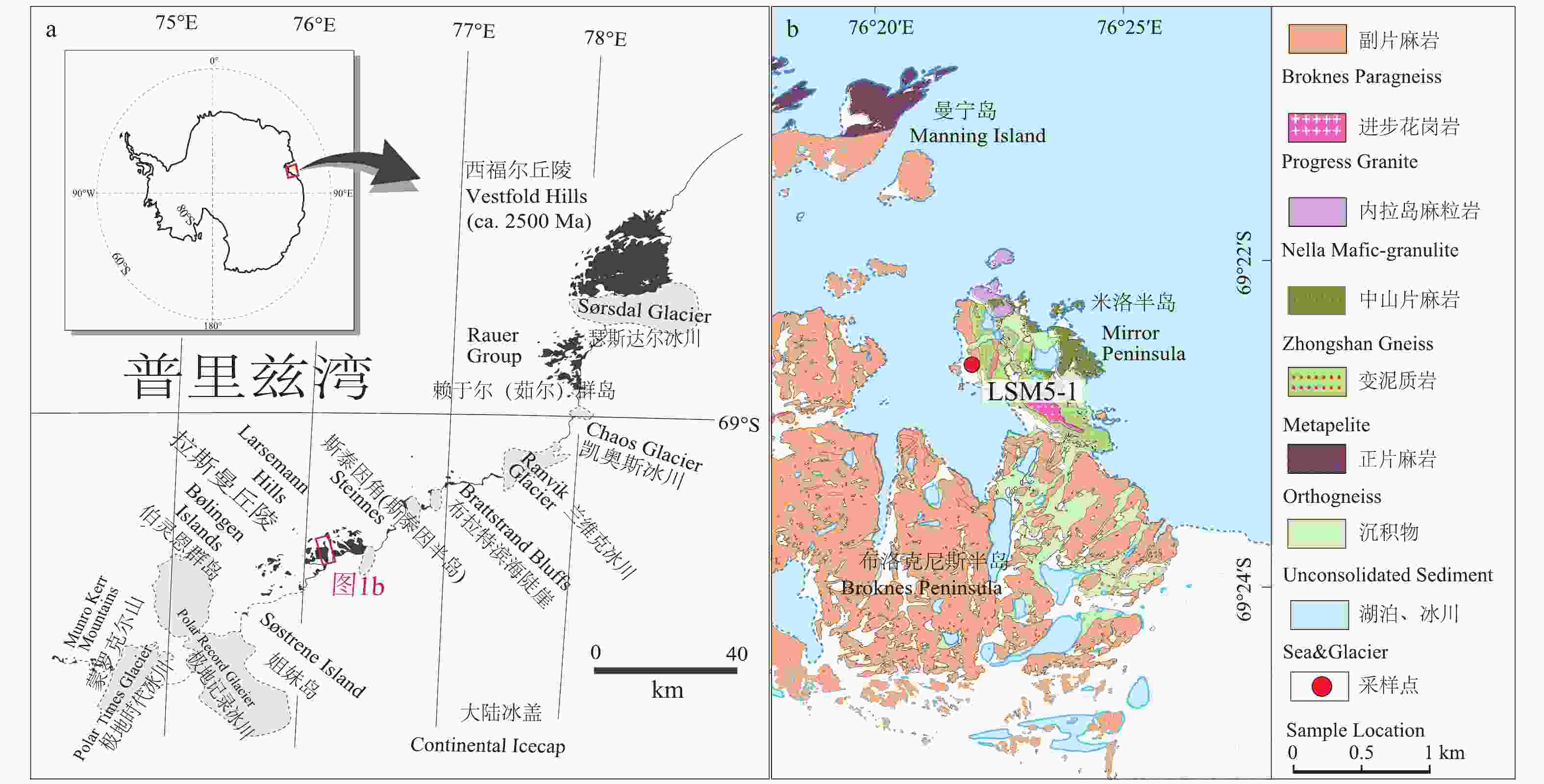
 下载:
下载:
